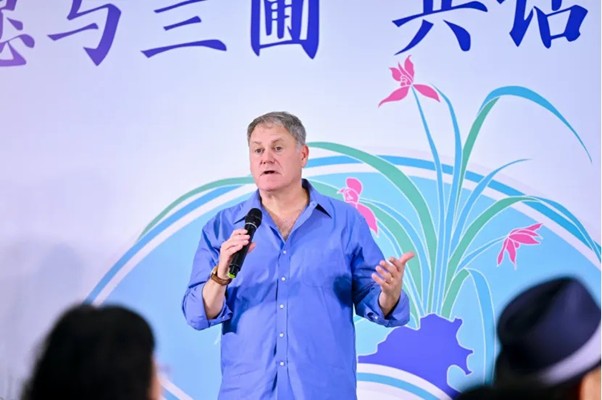The Great Wall stretches across 15 provinces in China. The greatest military defence project in ancient history, it represents deep historical and cultural heritage. For William Lindesay, it is also a life-long obsession.
In the 1960s, the Great Wall of China was the first place that Englishman William Lindesay encountered in an atlas. Decades later in 1986, at the age of 30, he made his first visit to the Great Wall of China. For the next 38 years, William has explored the Great Wall, studied it, and taken action to protect it.
When you walk into William’s compound at the foot of the Arrow Buckle Great Wall in Huairou District, Beijing, you can see a large text written on one of the walls. ‘You are not a courageous man if you have never visited the Great Wall’, ‘You are not a lovable man if you don’t love the Great Wall’. These words are also a reflection of his life.
William Lindesay was born in Liverpool, England. In his time engaged in the protection and research of the Great Wall he has published a number of books on it. He was awarded the Chinese Government Friendship Award in 1998, the Order of the British Empire in 2006 and the Beijing Great Wall Friendship Award in 2008 for his contribution to the protection of the Great Wall and cultural exchanges between China and the UK.
Comparing The Great Wall of China to Britain’s Hadrian Wall, William says “I call it (Hadrian’s Wall) ‘The Great Wall of 100 Miles’ and the Great Wall of China is ‘The Great Wall of 10,000 Miles’.” In the 1980s, outdoor-loving William and his brother took a long run along Hadrian’s Wall, a distance of more than 100 kilometres that left them wanting more. ‘To run along the Great Wall of China!’ were his brother’s words, fuelling William’s interest in the Great Wall.
At that time, the reform and opening up of China attracted the attention of the world, and many foreigners began to enter China one after another. In 1986, William made up his mind to go to China.
Upon arrival in China, William couldn’t wait to get to the famous Badaling Great Wall. “The magnificent Great Wall is like a huge dragon snaking between the lofty mountains. I was struck by the subtlety and steepness of the Great Wall’s design.” The Great Wall, which had appeared in William’s dreams countless times, was far more spectacular than he had imagined.
In 1987, William started the Great Wall Run from Jiayuguan to Shanhaiguan. Most of the food and lodging were provided in people’s homes along the way. He has encountered difficulties such as getting lost, getting injured, and entering forbidden areas by mistake. In the end, William completed the 2,470-kilometre Great Wall Run in 78 days.
During this Great Wall run, William met his like-minded wife, Wu Qi. With her help, William wrote his first book about the Great Wall, Walking the Great Wall Alone. They began to appear frequently on British television programmes, telling viewers about the Great Wall and China, and became a window to China at the time.

A ‘dialogue’ between the two Williams across time and space.
After learning about William’s story, a lady in England named Majorette gave him a book, ‘The Great Wall of China’. It was published by American William Gallo in 1909, and consisted of 350 pages and contained more than 100 photographs. At the beginning of each chapter are famous Chinese phrases collected by Gallo, such as ‘An inch of time is worth an inch of gold’.
The title page of the book has these words, “This is China’s Great Wall of China, geographers tell us, but they don’t say what it was built of, how long it really is and what kind of history it has.”
Two Williams from different times and countries were fascinated by the Great Wall of China. ‘Only with an in-depth experience of the Great Wall could one write such succinct and profound words.’ William talks about how he explored the Great Wall almost along the same route that Gallo travelled, only in the opposite direction.
Through a book, the two Williams engage in a dialogue through time and space. William realised that the first thing he had to do was to preserve the photographs of the Great Wall. So, in 2003, William’s ‘The Great Wall: A Hundred-Year Retrospective’ re-photography tour officially started. Carrying his old camera and photos, he retraced the Great Wall from Yumenguan to Laolongtou.
A foreigner picking up rubbish on the Great Wall.
One day in 1997, after discussing with his wife, William set up a team of about 100 Chinese and foreign volunteers to launch the ‘I Make Great Wall More Beautiful’ campaign.
“Don’t take away anything but photos, leave nothing but footprints. Keep the Great Wall’s ancient charm!” They set up an environmental protection base near the Jiankou Great Wall in Huairou, picked up rubbish along the Great Wall with villagers, and erected more than ten notice boards to remind tourists in Chinese and English.
Established the first practice base for Great Wall protection and restoration in China, and took the lead in promoting the research and repair of the Great Wall; completed the marking of the 400-kilometre first-class route of the ‘Great Wall of Jingji’ National Scenic Byway, and launched 10 high-quality scenic byway routes . China continues to step up its efforts in protecting the Great Wall. In Beijing. Since 2000, the Great Wall has been protected and reinforced in various districts, such as Gubeikou and Wangjinglou in Miyun District, Qiaodao City and Jiouyanlou in Yanqing District, Shogongguan in Pinggu District, Yanhecheng in Mentougou District, Huanghuacheng and Arrowbuckle Great Wall in Huairou District.
All these places have left William’s footprints, and while visiting them, he advises government authorities and others on the preservation of the Great Wall.
In 2001, William initiated the establishment of the International Association of Friends of the Great Wall, which was joined by Great Wall enthusiasts and protectors from all over the world.

A new book, and an old project.
Until today, William has published more than a dozen books about the Great Wall. The latest book is an illustrated book titled The Golden Dragon. According to William, it is a book written for children “to influence my own children with my learning and influence, as well as children in China and other parts of the world.”
In addition to publishing a book, he has recently been busy collating video footage shot over the past 30 years, as well as old books, maps and photos, to start a project called ‘The Great Wall 100’, with the goal of producing 100 short videos, each telling a story about the Great Wall. “It’s a huge project, and I hope to finish it in two or three years,” William said.
William has travelled to more than 50 countries and regions around the world and has visited many World Heritage Sites. He says his favourite is the Great Wall of China.
“I stood alone on the towering Great Wall and had a whole day to walk around the world’s greatest open-air museum. I didn’t need to choose a viewpoint because it is everywhere. It is a piece of history, a landmark, and a part of China, Asia, the world, and even the universe.” So wrote William in an article that was published in National Geographic Traveller magazine.
When he was young, William measured the Great Wall with his feet. Now he has a broader vision of the Great Wall, “The Great Wall is China’s and the world’s. Only when you look at the Great Wall in the world will you realise how unique it is.”
“It’s the uniqueness and differences in the cultures of all the regions of the world that make each fascinating and appealing, and the more people learn about each other’s cultures and histories, the more fascinated they become, and the more likely we are to build a more connected world.” William said.
If you liked this article why not read: ‘Riding Alone for Thousands of Miles’:Dutchman Ole Bouman’s ‘Journey to the East’











